Auto - Show Biz clinic originally published at Auto - Show Biz clinic
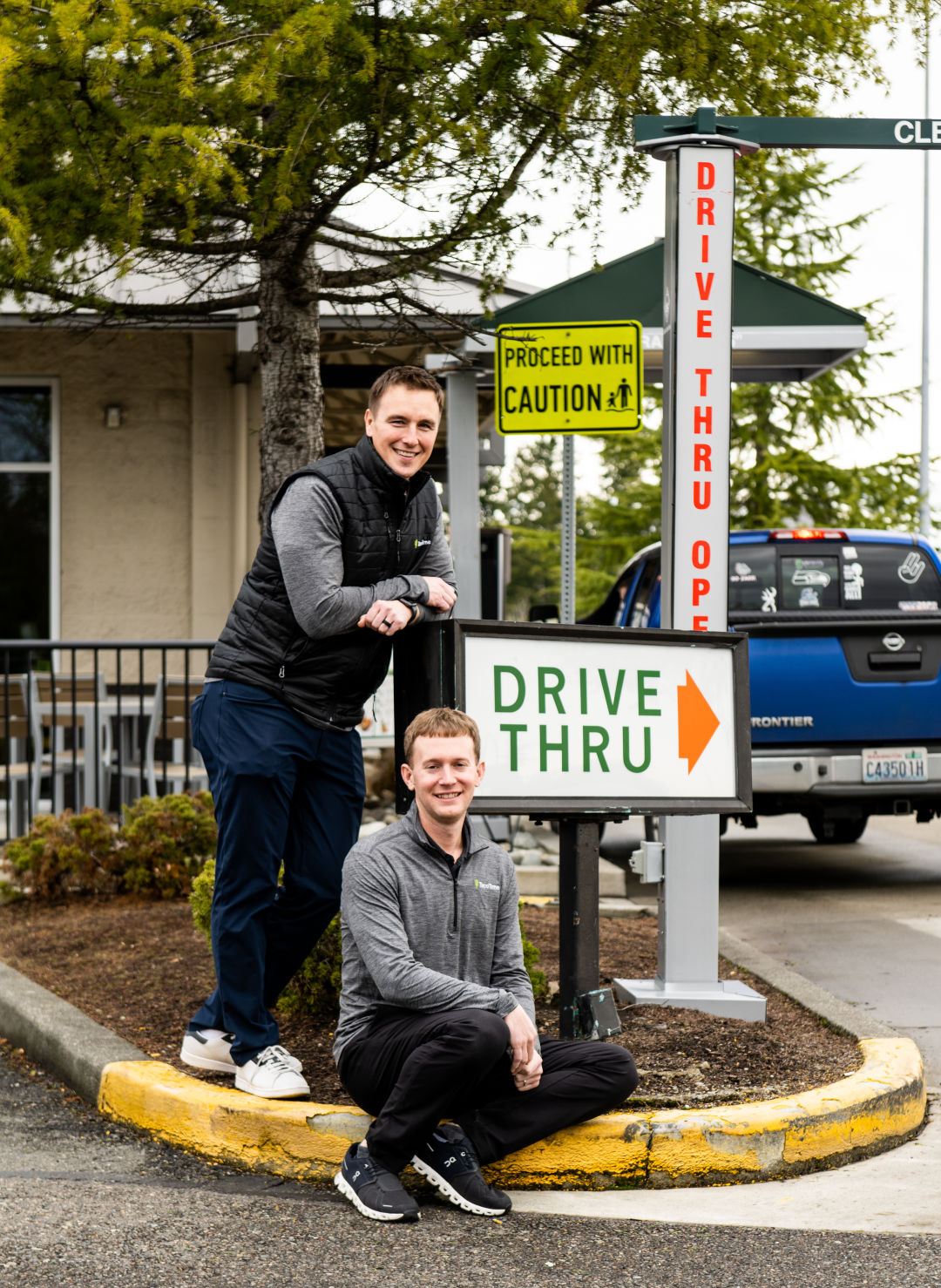
It was not supposed to be a podcast on Taco Time.
James Lin and Amy Faulkner created Dear Elite Reviews10 to discuss how reviews like Yelp can impact small businesses and restaurants. The accidental benchmark was revealed during episode six, when Melissa Miranda, Musang chef, spoke to them. Miranda refers to one of the Northwest’s most revered fast food chains as a reference during a discussion about whether one restaurant can appeal to everyone.
The podcast hosts explode with opposition when they hear the words “Taco Time”. Faulkner, an original New Yorker, says “total garbage”. Lim, who was born in Bothell, explodes with the kind of cheers normally reserved for overtime wins. Miranda is not the kind of chef you would picture eating at restaurants with a drive-thru window or a menu that offers combo meals. You can see her face in a recent issue Food & Wine. Her dad captures the squid she uses for her seasonal pancit.
The (mostly), joking contention about Taco Time between Dear elite reviewer became a theme. It became a litmus-test. Each subsequent guest was asked by the podcasters to give their opinion about the restaurant.
A clear pattern emerged. Anyone who grew-up in Seattle raved about Taco Time’s hot sauce and large-sized soft tacos. Robin Wehl Martin, Hello Robin cookie bakery, loves the nugget-shaped Ice Cubes – “it’s so pleasant to crunch.” Lim, however, recalls that non-natives didn’t share this enthusiasm. “I understand it is the best we get from people out of town. But I disagree.

I arrived 13 years ago in Seattle and the chain has never been on my radar. Yes, I drove past the extravagantly mirrored location in Wallingford. I even ate at the Interbay one while accompanied by a diehard fan. Taco Time isn’t a unique option for those who don’t know the place. These restaurants are easily lost in a sea of other drive-thrus. Del Tacos, Blue Water Taco Grills and Taco Bell are just a few of the many Mexican restaurants that offer soulless Mexican food. In 1962, Glen Bell, a white man, founded the chain in Los Angeles. The same year Frank Tonkin Sr. opened the first Taco Time Northwest here at White Center in White Center was Glen Bell. According to family legends, customers couldn’t pronounce their signature menu item so they ordered them as “taycos.”
Months following
Dear Elite‘s initial season. Lim recalls his first Taco Time experience, when his dad would take him to Canyon Park after soccer games to get a crisp burrito. Lim is a long-time coffee professional and owns Watson’s Counter, Ballard. Lim has a precise palate and prefers Taco Time to southern California’s In-N-Out. This is the hottest take on regional fast food. However, his passion comes with some caveats. He says, “It’s clearly a complete bastardization Mexican food.” Taco Time’s menu is “this weird Mexican-Tex-Mex, Pacific Northwest thing.” In a world full of Taco Bell-KFC hybrids and golden arches, long-standing local fast food chains such as Burgerville and Wisconsin’s Culver’s to our south and Texas’s Whataburger to our north, these beacons reflect and reinforce our regional identities. Dick’s Drive-In is perhaps the most prominent fast food establishment in Seattle. With its neon signage, this burger chain is in line with our vision of Seattle that we want the country to see. Employee benefits, hand-cut fries and 1am stops after a night at Capitol Hill bars are just some of the many things that this burger chain has. This is the stuff of Macklemore videos and Sir Mix-a-Lot lyrics. Taco Time Northwest is Seattle as it really is: progressive and earnest, struggling with our whitewashed history. We are not looking for attention. Just over here, we are making our own hot sauce.
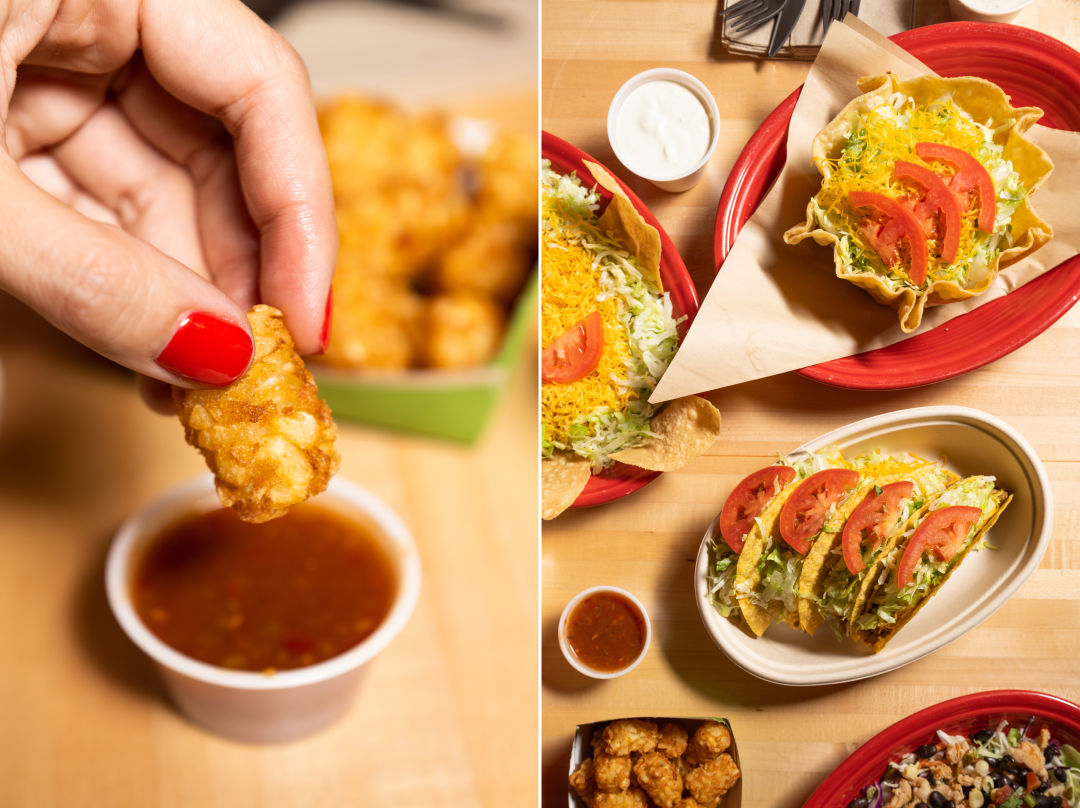
Hepburn’s worked here a lot lately, helping to train a new hire. Since 1985, she has been with the company as a crew member at the old Rainier Ave location. She recalls that she told people that this was a part-time job while she went to college. Nearly forty years later, she is a district manager. By 9:15, the staff is ready to cook the first of many batches of chicken. The morning’s tasks include dicing tomatoes for the pico-de gallo, making salsa (both mild and spicy red), and steaming the hot sauce in a commercial steamer kettle. Taco Time employees spend approximately three hours each morning cooking the kind of food you wouldn’t find in restaurants like this. Is it fast food if people hand-shred lettuce heads and 40-pound blocks aged cheddar from Sunnyside’s Darigold?
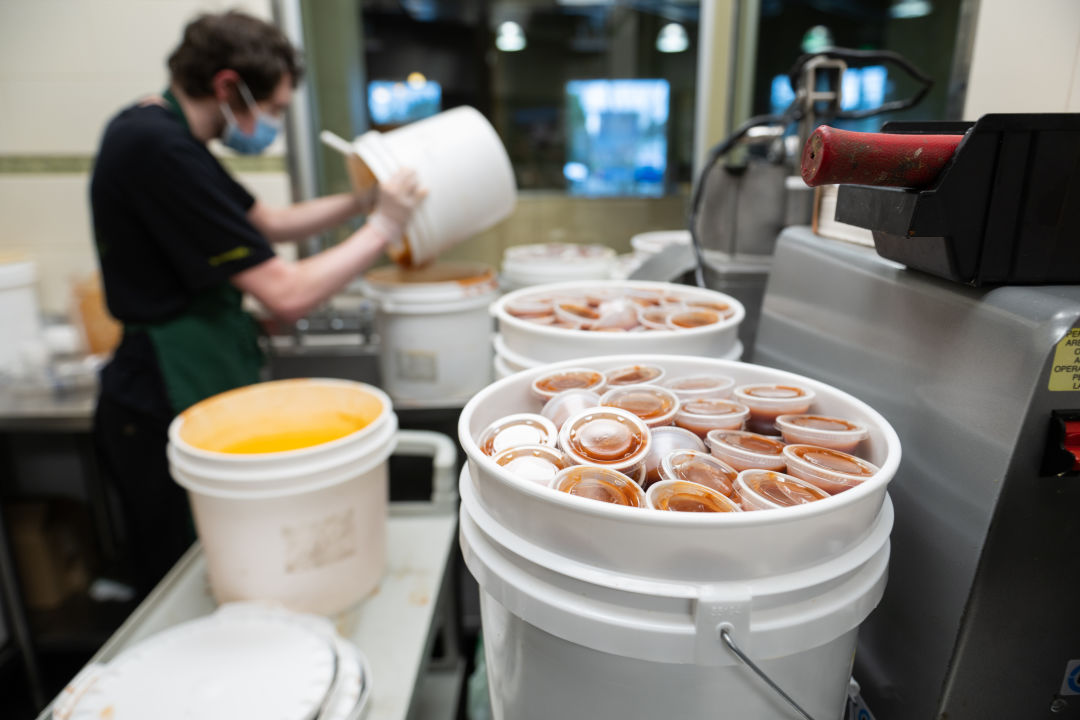
Game of Thrones
.” Nor is it Succession
. Robby’s voice sounds happy and cheerful; Chris has a streak for mordant humor that always comes through. Both use the word “heck”, but not in a way that gives the impression they would rather say “hell.” They are both copresidents and have introduced an ordering app and purchased back franchised locations to ensure restaurant operations are more under their control. If it wasn’t for their inability to optimize or disrupt the food industry, you could easily mistake Taco Time presidents for two tech-savvy members of Seattle’s badged tech crowd.
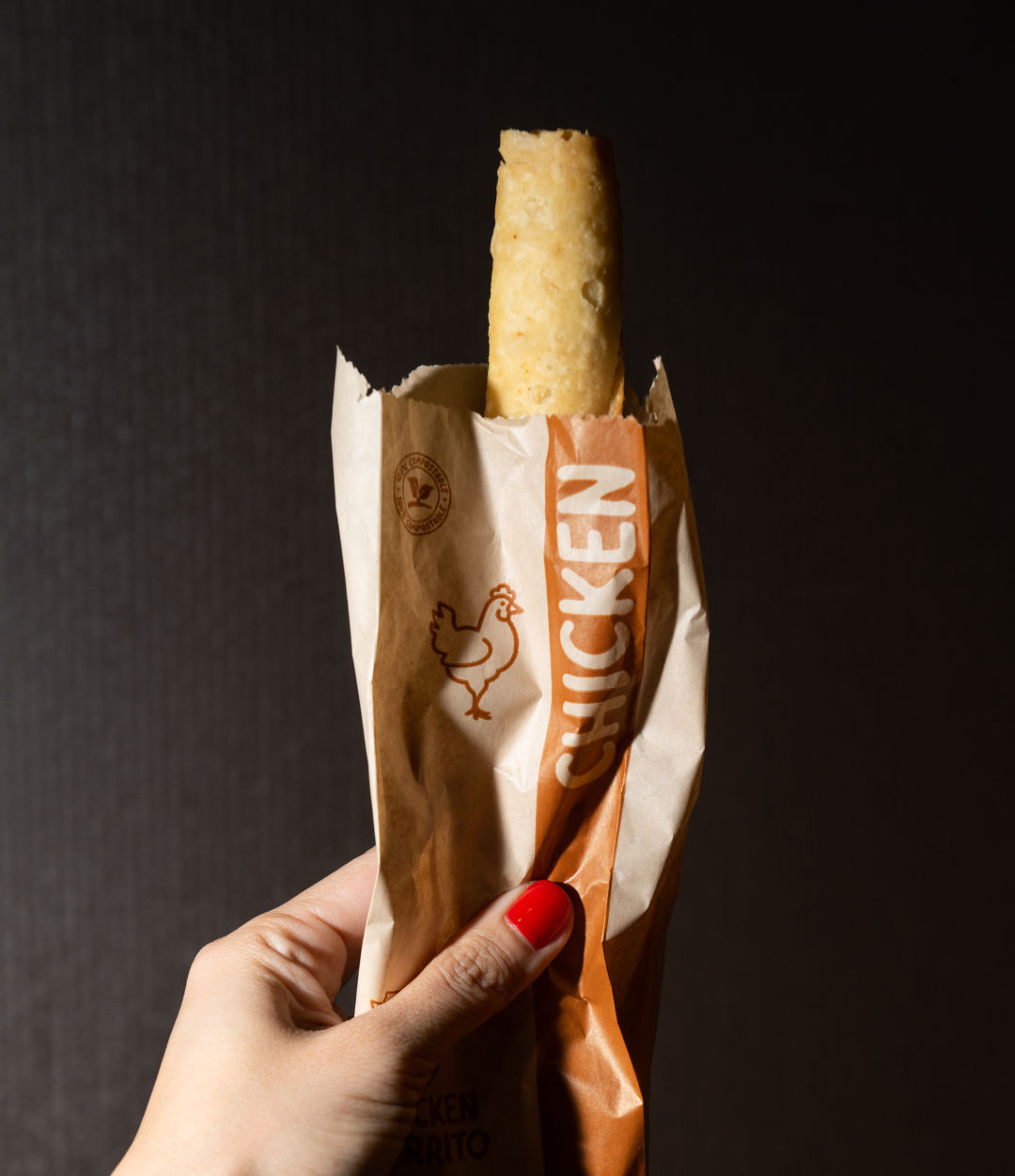
Texas Monthly
10 magazine. I gave it to him. His book American tacos explores regional styles from Memphis to California. The man is both a bard and a scholar when it comes to tacos.I expected him not to eviscerate Taco Time’s menu. Ralat enjoyed the bite-sized crisp burritos. He says, “The Baja taco line is boggles mine.” “Flour tortillas don’t really exist in Baja.” Ground beef is also not. “And ranch dressing? What is this? “But the menu tracks with some similarities he’s seen within our quadrant of America. Like his preference for flour tortillas over corn. The necessity to include tater tots is a Northwest invention. Or Taco Time’s dessert of fried tortilla strips, dusted with cinnamon and sugar. Ralat says, “It’s almost as if all these little chains came together and decided, ‘This is how Northwest fast food Mexican will look like.’” Ralat draws an existential line to Taco John’s. This massive chain originated in Wyoming and is now the trademark owner of the phrase “Taco Tuesday.”
Ralat has seen the taco’s inclusiveness and ability to reflect the truths surrounding it. Washington’s case is an example of this truth. The fact is that the tacos that made it into our midcentury mainstream didn’t have much to do with their cultural origins. However.
“I don’t believe white people tacos,” says he. “I don’t believe they exist,” he says. Taco Bell employs and serves all demographics. “Is it really white people food? If everyone’s eating it?”
When Randy Cote
and Patrick arrived at Sea-Tac, tired and worn from a nine-hour flight from Tokyo to the United States, they didn’t speak a word about their first meal back home after a week and half in Japan. They didn’t have to. After the couple had retrieved their checked luggage, Patrick turned to Cote, and said, “I’ll just have the usual.”
The normal, of course, is Taco Time. Cote enjoys crisp burritos and chicken soft tacos almost every week when he’s not in the States. He was once featured in an ad campaign for Taco Time Northwest because of his fandom. In July 2018 he embarked on a project–which he calls simply “the quest”–to visit all 77 Taco Time Northwest locations.The journey began when Taco Time introduced an app, and with it, the ability to see your purchase history. Cote had already visited about 10 locations while just going about his daily life. He keeps a meticulous spreadsheet which records all of his official visits, which now totals 69. The rules are simple: He must order from the inside and eat in the dining area. Drive-thrus don’t count.
For most their adult lives, their city has been changing with the speed of tortillas being fried in a fryer to make chips.
The “notes” section of Cote’s spreadsheet lists post-hike tacos with friends at the Factoria location or meals taken before and after hockey practice in suburban areas. His Taco Time visits paint a picture of a life with a lot of love ones, hobbies, and outdoor time. It’s difficult to not be misty-eyed over the retroactive entry for December 30, 2015. “Reintroduced My Future Husband to Taco Time.”
Cote’s dispatches at various points of “the search” eventually landed him a gig as a cohost on another local podcast. This podcast was not like James Lim’s
Dear Elite Reviewser
but it was specifically intended to focus on Taco Time Northwest.
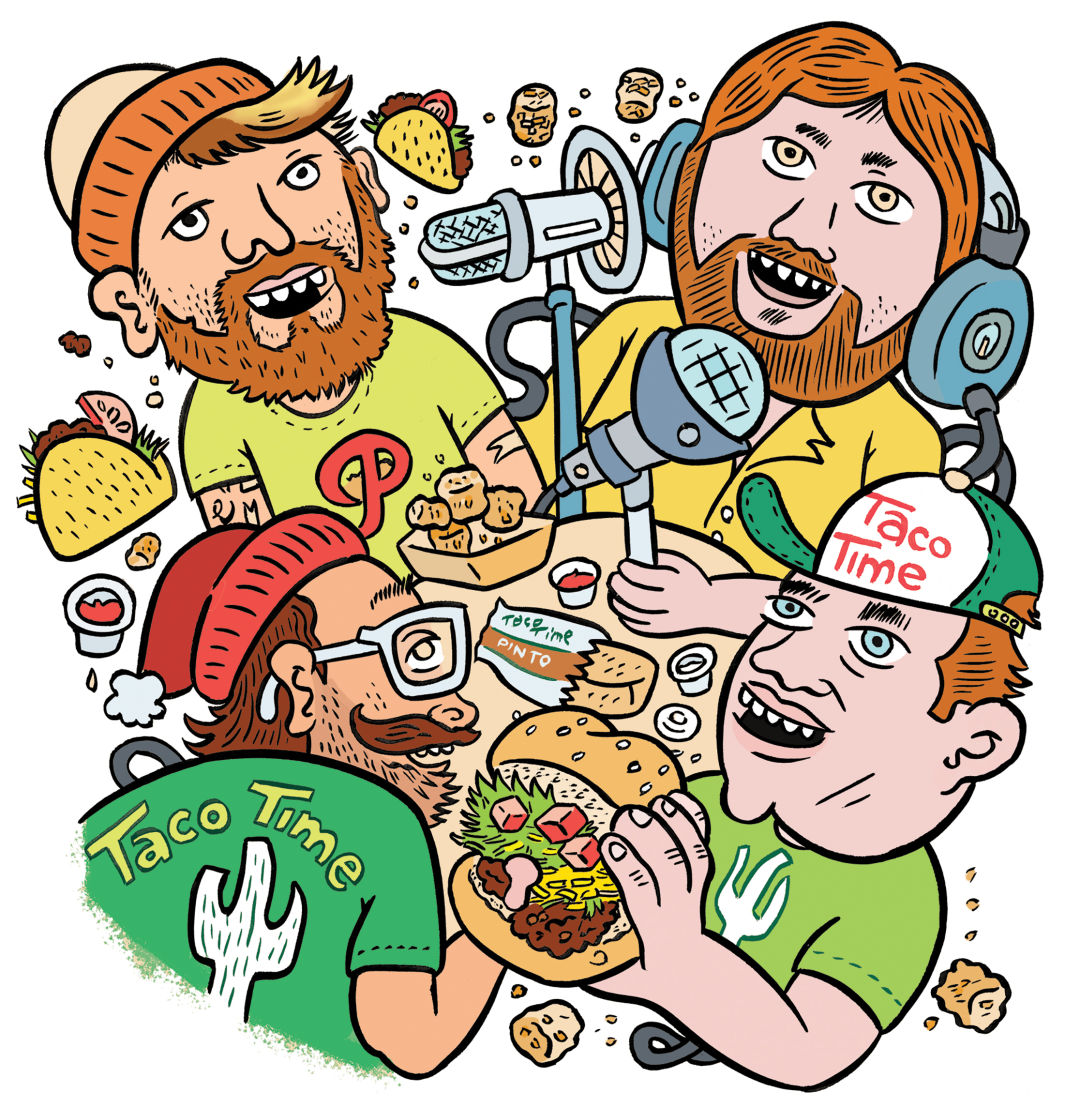
Talkin’ Taco Time met at Kevin Pelton’s West Seattle home to record an episode. On various hats, hoodies and quarter-zips, local logos were represented: University of Washington; Pagliacci Pizza; Rainier Beer and, on Cote’s T-shirt the official Talkin’ Taco Time logo. Pelton and his brother, Tristan Carosino, sat in Pelton’s minimalist living room eating doughnuts, and razzing one another like people with a long past.By the day, Pelton writes about NBA basketball for ESPN. Tristan Carosino was his brother and grew up in the suburbs near Sea-Tac. The siblings started The Fabulous Peltoncast
a decade ago to turn their commute-time phone calls regarding sports into a pod. The conversation often turned to food. Debating the city’s best fried chicken or pizza or tacos also helped fill the quiet summer season, when the Mariners didn’t have much to report.Talkin’ Taco Time began in 2018 as a semi-joking spinoff. Jake One, a local music producer, joined the podcast to discuss his high school job at the Bothell location. He quit after making 20 soft chicken burritos for his companions out the door. Pelton and Carosino brought in their childhood friend, Chris Smith, whose combined six years as a Taco Time employee somehow left him even more enthused about the company than when he started.
While the brothers certainly enjoy a good soft taco or crisp burrito, their podcast began not as a paean of superfandom, says Carosino, but as a gateway topic. “It opened up an opportunity to talk with people from Seattle.” Smith manages bands in both local and national venues and Taco Time promised a surprising way to engage musicians or athletes. These notables are tired of answering the same interview questions over and over again. There are only so many ways to talk about your first album or next season.
It’s hard not to get misty-eyed over a spreadsheet entry from December 30, 2015. “Reintroduced My Future Husband to Taco Time.”
Almost Live
and hear Taco Time jingles through TV commercials. In the middle- to late-1990s, Seattle was a smaller place than it is now. Before the rise of Amazon, Starbucks, and the glory days of Boeing, Seattle relied heavily on sports for its identity. Taco Time’s logo was featured on the backs of Seattle Sonics trading cards as well as on commemorative cups next to a cartoon of Ken Griffey Jr. holding the Mariner Moose in his arm. The common thread that connected all trips through Taco Time’s drive-thru was so obvious and ubiquitous that nobody thought about it.These were also the years when Seattle became cool. Cote recalled watching his small city explode into the national zeitgeist. It was the era that Nirvana and Frasier were popular, as well as Sir Mix-a-Lot. MTV filmed a season
The Real World
10 here; both the Sonics and the Mariners were contenders. Cote recalled Bob Costas coming to the Key Arena to broadcast the NBA Finals. His hometown was a small, remote city for many years. He says that suddenly, people noticed Seattle. His nostalgia for this era is deep. Cote doesn’t forget that Taco Time was founded the same year his employer, Space Needle. “It’s all part and parcel of this strange fabric. This place is full of unique and quirky things, and we are all in on the joke.On rainy afternoon
in Beaverton, Oregon, a Taco Time sign greets you from a suburban intersection. It’s the familiar name, a cactus with a shrug emoji-like appearance. But there’s something wrong. The Tonkin family’s Tonkin totem is louder and more raucous than the cactus. Technically, the sign reads “TacoTime”, all one word. Inside, I find familiar tacos, crisp burritos and Mexi-Fries. They are also on a smaller menu. There are also unknown burritos with sweet and savory carnitas, or chicken strips.
I squint at my menu. “What’s in the stuffed Mexi-Fries?” I ask a woman wearing a blue shirt and an apron, who is taking my order.
“Like, cream cheese, and a bit of jalapeno,” I ask. “They’re pretty tasty.” This is the first time I discovered Kit Kats in Japan come with a wide range of flavors. Although I haven’t yet left the country, I have reached a significant demarcation in Taco Time.
I have not left the country but I have crossed a huge demarcation in Taco Time.
Fast food is fine. It’s a step above Taco Bell. Even the twinned menu items like the crisp taco have that chemically induced ghost taste that is typical of drive-thru food. Although the staff is friendly and warm, I am still not over the large tostada that has a large flour tortilla wrapped around, shaped like a flying saucer dumpling. Taco Time Northwest locations receive coupons for burritos that don’t exist in reality. Or they go to tacotime.com to place an order, when they really want the menu at tacotimenw.com. Robby Tonkin, a representative of his company’s corporate doppelganger, says it is frustrating. It’s very different from what we’re doing. It’s very different than what we do.”
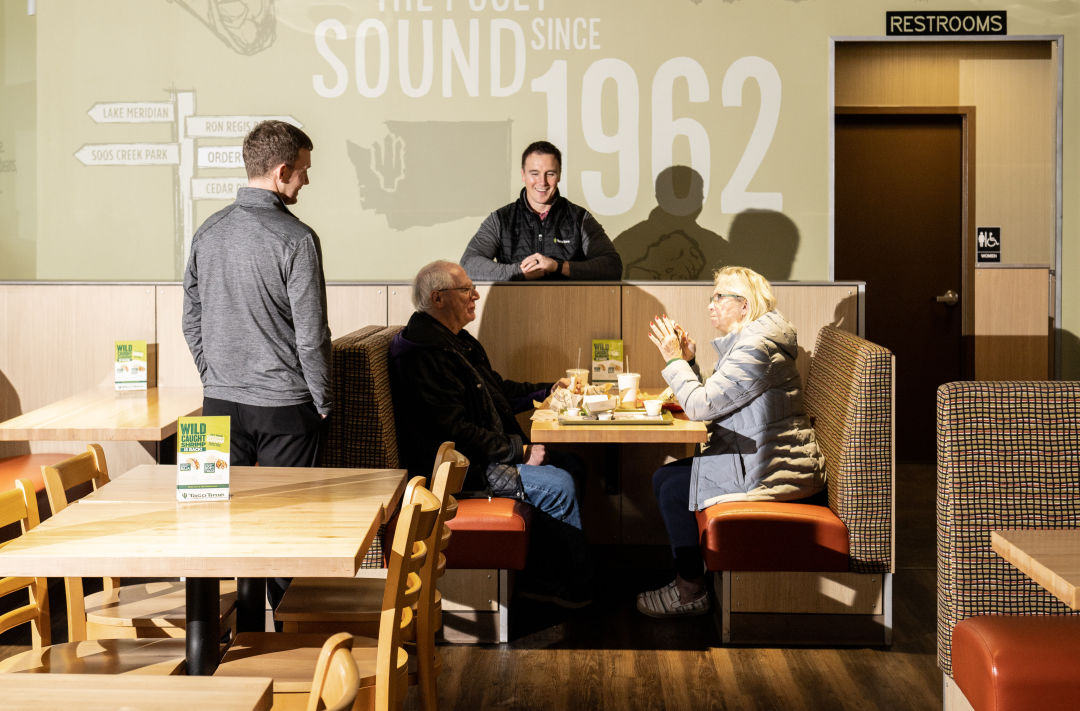 These differences are stark, but the resemblance between them is not accidental.
These differences are stark, but the resemblance between them is not accidental.Things went well for a while but “at its core, our great grandfather was a restaurant operator,” says Chris Tonkin. Fraedrick, on the other hand, “was just franchising for anyone.” This didn’t go down well with Frank, who was a man who loved hospitality and food service. By the time he entered the tayco business, he had already started Tonkin’s Cafe as well as a burger stand called Bif’s.
In 1979 Frank Tonkin made a deal to partner with Ron Fraedrick. He would form his own company and claim Washington’s western half as his territory. Tonkin managed Taco Time Northwest, while Fraedrick built what is now Taco Time International. The latter now has over 300 franchises across the globe, from Canada to Kuwait. It is part of a Scottsdale-based holding firm, which also owns Pinkberry frozen yogurt, Cold Stone Creamery, and the sub sandwich chain Blimpie. It’s strange that nobody thought of changing their names to avoid confusion. Chris Tonkin points out that “When they split up, the internet was not available.” This arrangement is unlikely to work today, but it gives us an opportunity to study twins who were separated at birth and then fostered on very different commercial values. The ad suggested tater fries.
Tater fries? He stared in disbelief and then consulted Taco Time’s ordering app to confirm that this unannounced rebrand was real. Taco Time’s tater tots are a top-selling item since its inception.
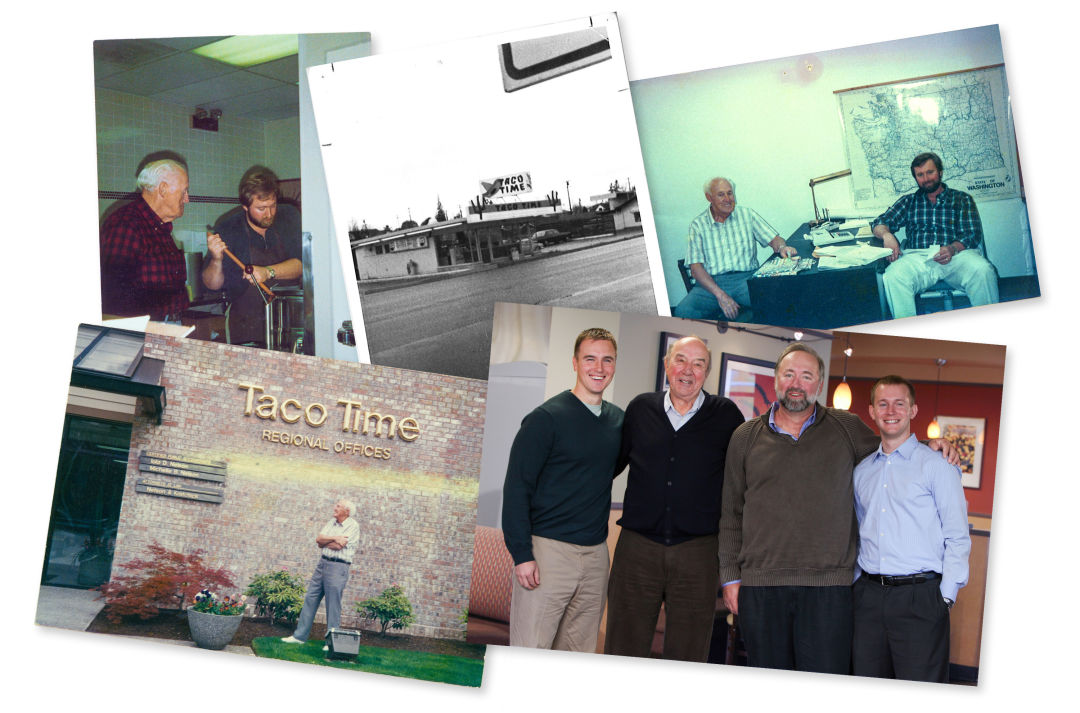
The hosts
Talkin’ Taco Time
convened a pod to discuss the seismic name change. They explored the options from all angles. It was November 2020, the close of an year in which many companies had examined their blind spots and found ways to be antiracist. The consensus was that “Mexi” should be dropped as a diminutive prefix. However, emotions were high. “The name is unacceptable,” Cote says of the new moniker. Plus, complained Chris Smith, “the word ‘tater’ is just stupid.” (Not to mention redundant when you pair it with the word “fries.”)
Subbing in such a bland term felt especially egregious for the menu item that regularly lands in the final four of the podcast’s annual Taco Time menu bracket. It also ruins part of the secret-handshake appeal which inspired the podcast about Taco Time.
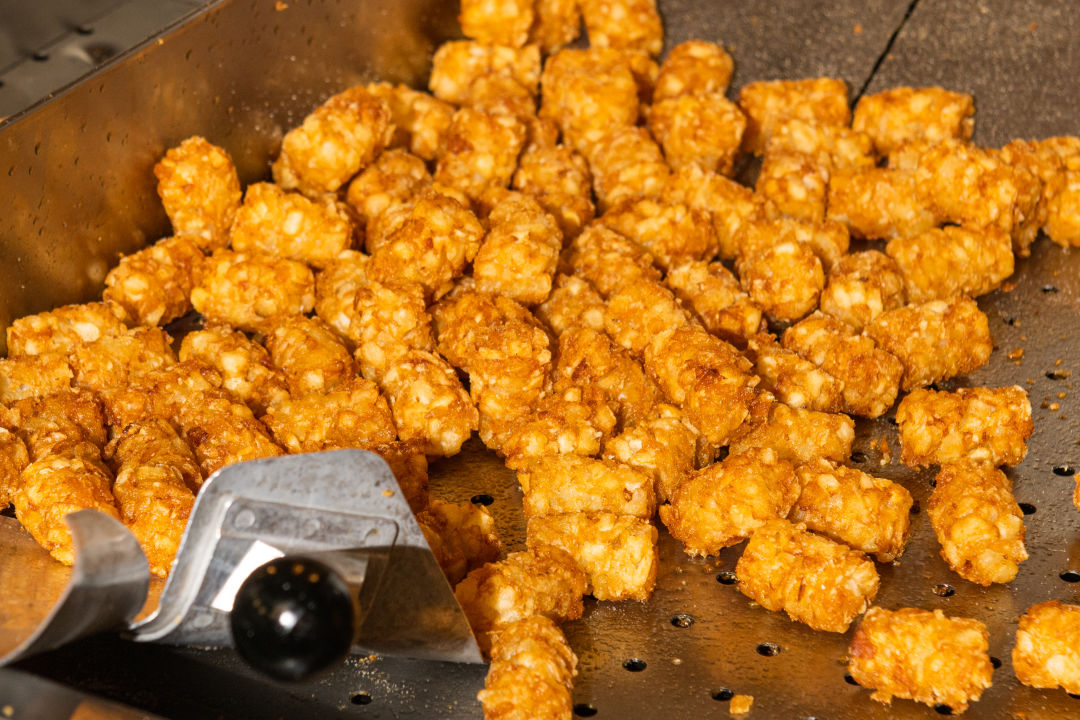
The kookiness that comes with having a Mexican-Fries item that is actually tater tots is part of the restaurant’s very special culture. Pelton says, “It’s a telling if you call them Tater tots.” It’s a sign that you aren’t from this area. Carosino frames it in sweeping terms: “That’s part of the history, that’s what’s in our blood…generations growing up with Mexi-Fries, being in on this conversation.”The name change, enacted over Halloween weekend, received little attention outside of the podcast and the occasional subsequent Reddit comment. The Tonkins are atypically understated about their decision. Chris Tonkin says that calling a big press conference “is the contrary of how we operate.” “We didn’t come up with this name.” “It didn’t feel right.” Robby says that everything can be so political. “We would prefer not to have barriers to our food. The key thing is people still order them.” Taco Time’s reluctance to talk about itself could be just as responsible for locals’ obsession as it is for newcomers’ puzzlement.Back on the emergency pod, Pelton comforts his compatriots. Their city has been changing for most of their adult lives with the speed of tortillas being fried to become chips. It’s easy for Taco Time to lose its unique qualities. It is possible that a Seattle institution, a fixture of Seattle’s upbringing, might be replaced by a generic experience like the new building that adorns our cityscape. Pelton offers consolation: “The soft tacos actually burritos.”
Auto - Show Biz clinic originally published at Auto - Show Biz clinic